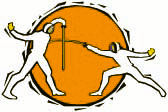Two competitive opponents are desperately fighting with swords in hand. The clinking of the metal adds to the anticipation of who will win the glory. Beads of sweat run down their faces as they struggle to strike their opponent. When one finally strikes the other with his weapon, they touch swords and begin again.
All this action, and the competitors
aren’t even standing. Welcome to the world of wheelchair fencing.

According to the Palo Alto
College website, more than 70 Kinesiology classes will be available for
the upcoming Spring 2005 semester. Wheelchair fencing is one of the sports
offered for disabled students.
Assistant
Professor Vincent Bradford coaches fencing
in the gymnasium, where beginning to advanced fencing students attend.
“Fencing is one of the sports that they (students) can sign up for if they’re
disabled,” said Bradford, who has 39 years of fencing experience and was
a fencing competitor in the 1984 Olympics.
One of the students taking Bradford’s fencing class is Kurt Oswalt, a freshman
majoring in Computer Science. Oswalt, who is wheelchair bound, was introduced
to wheelchair fencing by Bradford, who approached him after asking if he had
any idea what he was going to take for a Kinesiology credit.
During one of Bradford’s 50-minute long classes, students prepare themselves
by getting into protective gear that consists of gloves, jacket and mask. To
warm up, students are instructed to do fencing drills, like lunges, and point
control with their foil, the ‘stick-like’ rod used in fencing, that
helps improve their skills.
Bradford then tells students to find partners to practice tactical exercises
on one another. Because Oswalt is the only student in her class that is wheelchair
bound, his partner is seated across from him, both chairs at an angle. Bradford’s
lessons enable everyone to participate, both disabled and able-bodied students.
In tournaments, points are given when one of the competitors has the right of
way and touches his or her opponent on a prearranged target. In some cases,
there is no time limit. In those instances, competition stops when a given number
of points is reached.
Athletic traits, like speed, endurance, precision and flexibility, are applied
in fencing. On the intellectual side, possessing good strategies and tactics
is essential, and the ability to predetermine what your opponent will do next
will give students the advantage.
If you’re interested in entering the world of fencing, Bradford may be
reached at 921-5233 or <vbradfor@accd.edu>.